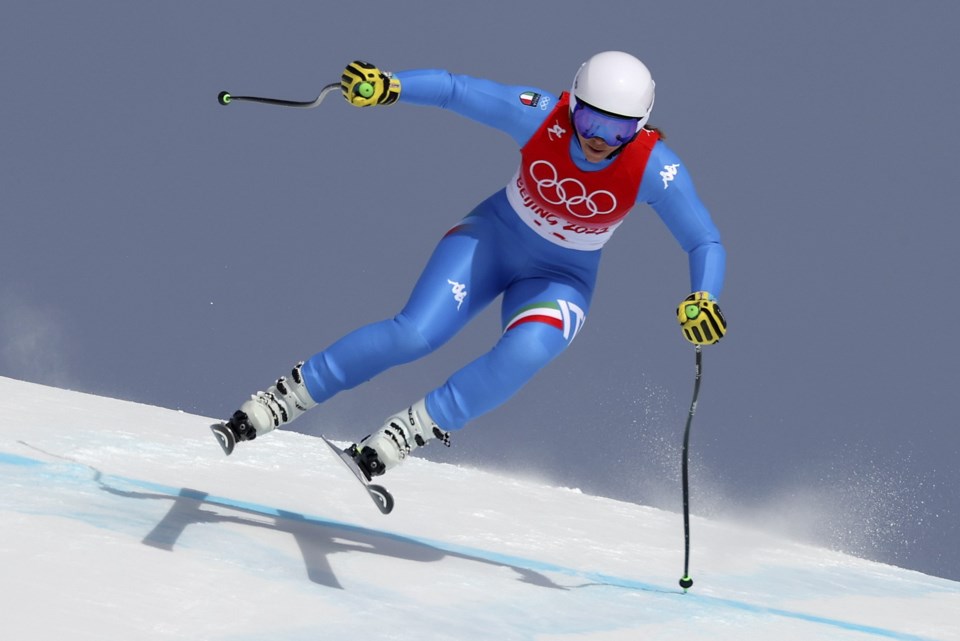BEIJING (AP) ŌĆö American skier Tommy Ford thought the cascading wall of large white flakes during the first snowy Alpine race of the Beijing Olympics left the slope for with a handful of ŌĆ£grippierŌĆØ spots and ŌĆ£a little chatter here and there.ŌĆØ
His U.S. teammate, River Radamus, described the course known as ŌĆ£The Ice RiverŌĆØ as ŌĆ£a little bit bouncy.ŌĆØ To NorwayŌĆÖs Henrik Kristoffersen, the precipitation rendered the hill ŌĆ£quite aggressive.ŌĆØ
A day earlier and a half-mile away on ŌĆ£The RockŌĆØ course at Yanqing Alpine Skiing Center, ItalyŌĆÖs Elena Curtoni offered an assessment after the that was entirely in her native language, with the exception of this English word: ŌĆ£Grip.ŌĆØ
Asked if there is a counterpart for that term in Italian, she shook her head. ŌĆ£Actually,ŌĆØ Curtoni explained, ŌĆ£we use ŌĆśgrip.'"
As in many sports, and plenty of other fields, Alpine skiing has a lingua franca ŌĆö words and phrases that allow folks from various places to communicate in a shared language. In this instance, much of it has to do with .
ŌĆ£ThereŌĆÖs a lot of terminology about the feel that skiing gives you when youŌĆÖre on a course. If a course ŌĆśpulls,ŌĆÖ itŌĆÖs bringing you to the gate sooner than you would expect. If the snow is ŌĆśreactive,ŌĆÖ it means itŌĆÖs easier to make a turn. ThereŌĆÖs subtleties you pick up along the way,ŌĆØ said on Tuesday is the only Alpine medal for the U.S. so far in China. ŌĆ£ThatŌĆÖs when you learn them: When youŌĆÖre with your friends and learning skiing. Sometimes you make up your own lingo. But thereŌĆÖs a common understanding.ŌĆØ
WHAT ARE THEY TALKING ABOUT?
LetŌĆÖs allow some American ski racers to explain what some of these things mean:
Grippy: ŌĆ£Dry, hard snow. We call it ŌĆśgrippyŌĆÖ because it really grabs at your edges. So, itŌĆÖs really easy to turn on. Sometimes itŌĆÖs easy to overturn on. But it also can be unforgiving with mistakes. You can easily catch edges. Grippy snow is your classic Colorado snow. It doesnŌĆÖt have to be manmade, but often itŌĆÖs manmade.ŌĆØ (Breezy Johnson)
On the edge: ŌĆ£Pretty much all of your weight is on a single edge on your (ski). ... (Or) if you make a mistake, itŌĆÖs going to be game over.ŌĆØ (Bryce Bennett)
Chatter: ŌĆ£When your ski is vibrating a little. ... Like rumble strips on the interstate.ŌĆØ (Cochran-Siegle)
Getting bounced: ŌĆ£When your ski hits a bump and then it kicks you off-line. ItŌĆÖs not like a clean turn. YouŌĆÖll hit a bump and then youŌĆÖll be off-line and youŌĆÖre in a different place than where you want to be.ŌĆØ (Bennett)
Sugary: ŌĆ£ItŌĆÖs soft snow but itŌĆÖs not new. Just straight-up soft. Sometimes at the bottom of the ski slope, if itŌĆÖs kind of warm, but dry, then at the bottom, where people walk around in their boots, itŌĆÖs sugary snow. ... ThereŌĆÖs no purchase on sugary snow. You try to turn on it and you just trench in and itŌĆÖs not very fun. ... We hate sugary.ŌĆØ (Johnson)
Rattling: ŌĆ£When thereŌĆÖs small, micro bumps within the turns and itŌĆÖs not smooth. ItŌĆÖs bumpy underfoot.ŌĆØ (Bennett)
WHY DO THESE WORDS MATTER?
They allow skiers to get a grasp of elements that can change the way they approach a race.
Often, these terms are used in course reports coaches or competitors relay to those who have yet to come down the hill.
ŌĆ£They do represent real things. TheyŌĆÖre not just slang and, like, ŌĆśOh, I was shredding!ŌĆÖ They really are critical to understanding the circumstance youŌĆÖre trying to convey to the other people,ŌĆØ said Bode Miller, whose six Olympic Alpine medals are an American record. ŌĆ£ItŌĆÖs ... specific and accurate terminology, because thereŌĆÖs a big difference between ŌĆśchalkyŌĆÖ and ŌĆśgrippy.ŌĆÖŌĆØ
Johnson, the runner-up at three World Cup downhills this season and considered a strong Beijing medal contender until surgery kept her home, split the lingo into two basic categories: snow conditions and surface conditions.
ŌĆ£You have icy, grippy, soft, bally, sugary and slushy. Those are the six main snow conditions,ŌĆØ she said. ŌĆ£And then you have surface conditions. Chattery, bumpy, smooth, I guess, are probably basically your three there.ŌĆØ
DOES IT ALWAYS MAKE SENSE?
Not necessarily. Markus Waldner, the menŌĆÖs World Cup race director, is annoyed whenever he hears skiers talk about snow being ŌĆ£aggressiveŌĆØ ŌĆö meaning, as with ŌĆ£grippy,ŌĆØ that there can be a strong connection between the skis themselves and the surface underneath.
Except Waldner points out that such variations have more to do with the equipment a racer uses than with the snow itself.
ŌĆ£Snow is never aggressive. The crystals of the snow can be different; there are 1,000 different (types of) crystals. But the snow is never aggressive,ŌĆØ Waldner said. ŌĆ£I tried to explain it to them: ŌĆśMy friends, the snow is not aggressive. The snow can be hard, soft, wet. Big crystals. More crystals. And so on. But not aggressive.ŌĆÖŌĆØ
A racerŌĆÖs technician can alter skis to allow for better contact.
One example: If the snow is "grippier,ŌĆØ Miller explained, ŌĆ£your technician might dull your skis back a little bit ŌĆö take a gummy stone to the tip and tail of your skis to make them less aggressive ŌĆö because the snow is going to be more responsive than it was on previous days on the same turn.ŌĆØ
WHO UNDERSTANDS THIS JARGON?
In a word: Everyone. No matter the country -- and there are 83 represented in Alpine competition at the 2022 Olympics.
ŌĆ£Oh, yeah. Their English is a lot better than my German or French or Italian. Some of the Norwegians probably have better English than we do,ŌĆØ Cochran-Siegle said with a smile. ŌĆ£WeŌĆÖre fortunate. We come across as a little not-as-well-educated with a lack of understanding of other languages.ŌĆØ
___
AP Sports Writers Andrew Dampf and Pat Graham contributed to this report.
___
More AP Olympics: https://apnews.com/hub/winter-olympics and https://twitter.com/AP_Sports
Howard Fendrich, The Associated Press


